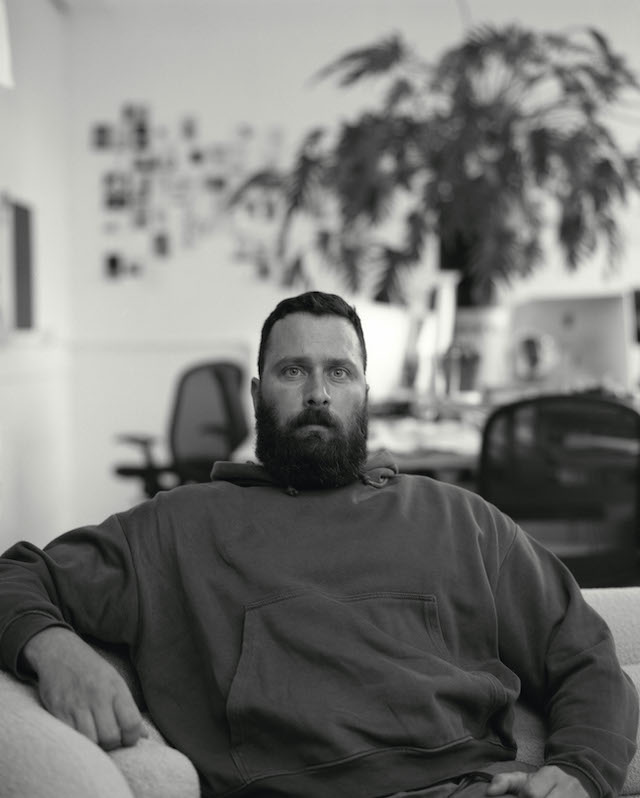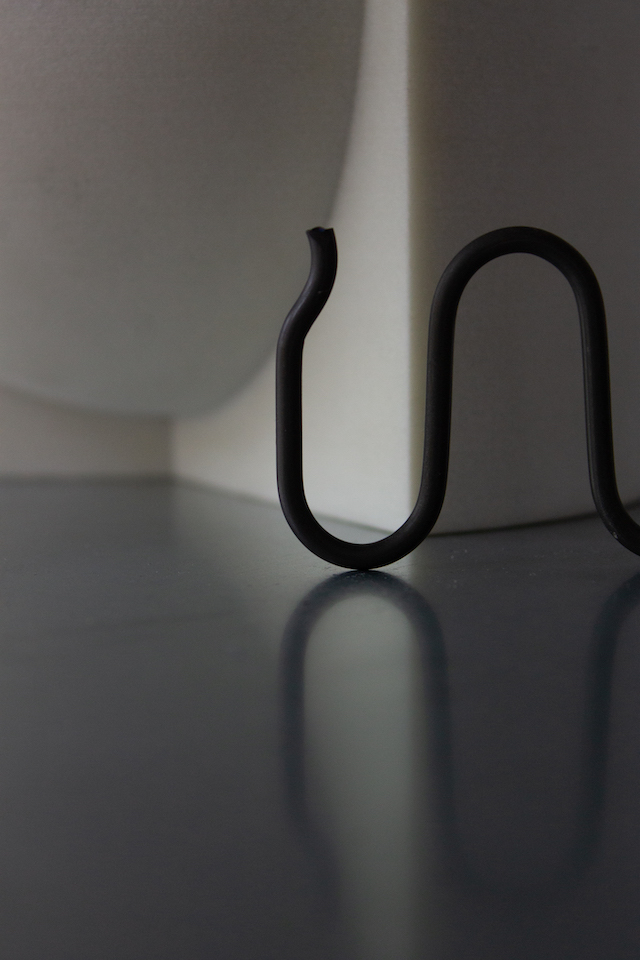The British-Canadian designer, who has worked for Tom Dixon and taught at the Royal College of Art, invites creative limitations to conjure his eclectic and soulful works – from chairs to buildings – into being

“Design works well when you set constraints,” says Philippe Malouin, who has worked in London since 2009. “We are always being told ‘Do what you want’ by the brands that come to see us, but no-limit design does not give good results. I would much rather be asked to design a chair in wood, with a given height and no arms, than to have no limits.”
If the client won’t spell out a limit, Malouin finds a way to do it for himself. The kind of constraints that he sets for himself range all the way from making a mass-produced mirror using only a single piece of standard stainless steel tube, to a limited-edition vivid yellow desk, entirely made out of nylon by casting it in a mould. (The trick with the mirror is to press the top two thirds of the tube flat very carefully, and then polish it until you really can see your face in it, while leaving the tube intact at the other end to allow the finished object to stand upright on a table. It’s yours for £125.)

The desk and a number of related pieces are collectively known as Industrial Office. The group includes a storage system, some smaller accessories – such as steel hooks, desk tidies and a hat stand – along with a nylon telephone and a desk chair made from hollow steel sections that seems to be channelling memories of the 1960s seen through the filter of cubism.
They are available from the New York art-gallery owner Jeanne Greenberg Rohatyn at her Salon 94 Design offshoot.

The constraint of making a mirror out of stainless steel tubing is, conceptually at least, not unlike the one involved in making a desk out of a single material and without fixings. But there are other things going on with the Industrial Office project too; not least that Malouin loves nylon. “It has a low friction coefficient, so you can make a sliding drawer without bearings; you can get fantastic colours; its hard wearing and if it comes to it, fully recyclable.”

He is well aware that to confess enthusiasm for plastic of any kind is about as transgressive these days as to go elephant shooting; but this is not some Trumpite attempt to deliberately offend. He is asking us to see this demonised material in a different way. By making it into a gallery piece he is doing the exact opposite of designing disposable single-use plastic bottles. “The desk will never be thrown away. Used in this way, the meaning of the material is completely changed,” he says. Industrial Office can also be understood as an epitaph for the kind of workplace that was once universal, but which had already taken on the wistful quality of an endangered species even before COVID-19 finally consigned it to history. The searing colour serves to dissipate the sense of melancholy.
The mirror and the desk are two very different kinds of object. One is made in relatively large numbers, the other has the aura of an editioned piece. But they both reflect Malouin’s belief in the continuing relevance of physical things that we can touch and feel.

Malouin, who was born in 1982, studied industrial design in Montreal and Paris, before moving to the Netherlands where he was a student at the Eindhoven Design Academy. He showed Grace, the inflatable table initially made for his graduation project, at the Cologne Furniture Fair. When fully inflated on its folding wooden legs, it’s big – able to accommodate 10 people – and sturdy enough for Malouin to be photographed standing on it. However, let the air out, and it packs away into a duffle bag. It was an inventive-enough idea to get him an internship in Amsterdam with Frank Tjepkema, one of the Dutch designers associated with the Droog group. Then Tom Dixon offered Malouin work in London, which allowed him to move to Britain in 2009 and set up his own four-person studio. He designs objects and furniture under his own name, but has also established a parallel architectural and interiors practice called Post-Office, which is responsible for, among other things, Valextra’s London flagship store and the Aesop HQ.
In 2011, Vienna Design Week teamed him with Lobmeyr, Austria’s long-established glass maker, which still produces the whisky tumblers and champagne flutes designed early last century by Adolf Loos and Josef Hoffmann respectively. Malouin designed an installation piece called Time Elapsed, made by Lobmeyr’s technicians. It involved a ceiling-mounted rotating arm fabricated from brass, slowly releasing the contents of a hopper full of sand onto the floor beneath, leaving a roughly circular trace. It could be understood as a chandelier of a kind, but it is also a reference to the use of sand in glass-making, and the act of time-keeping itself. “The flow of sand through an hourglass is traditionally used to keep track of elapsed time. It is also a physical representation of the fine line between the past and the future. Through the machine in this room, the deposition of sand forms, not minutes and hours on a clock face, but abstract and changing patterns, illustrating the link between time and decoration,” Malouin explains.

In the same year, Malouin became interested in the techniques used to make chain-mail armour. His researches eventually resulted not in the piece of furniture that he had originally considered, but in a rug, made from galvanised steel wire, painstakingly put together by hand; it took 12 people a total of 3,000 hours to finish. The starting point was a near-endless supply of pre-coloured galvanised wire, of the kind used to make agricultural fences. One of the team focused on tightly coiling the wire around a metal rod, on the end of a power drill, in a timber jig. The coils were hand cut into small rings and then riveted together one at a time in a traditional Japanese pattern that makes two rings, one on top of the other at the centre of twelve more rings linked into them, and radiates outward. The result is a deep textured metal rug that has both the quality of a woven fabric, but also of a three-dimensional object, an effect emphasised by the use of different colours for some sections.
Malouin sees himself primarily as an industrial designer, with a training that has equipped him to work for mass production. He is dismissive of his own skills as a maker, but uses them as an essential part of the design process. “We very often make things, badly, here at the studio in order to allow a design discovery to happen, and then it influences the industrial process.”

For the Industrial Furniture collection it was different. “Half the things were handmade by Julian Komosa and me. We taught ourselves to weld. We made cast rubber chairs.” But for Malouin making is more often a tool rather than an end in itself.
His energetic commitment to tactility, combined with his interest in giving objects qualities that go beyond innocent utility, make him an attractive choice for a certain kind of company. A surprising number of Malouin’s clients are brands such as Lobmeyr that have a long tradition of craft skills, but are also interested in finding ways of reinventing themselves.
1882 Ltd, established only recently but continuing a five-generation family tradition in the English pottery town of Stoke-on-Trent, is one such brand that is attracted to Malouin’s sensibility and enthusiasm for new materials: His Dunes collection is a series of plates and bowls of various sizes that makes the most of those skills. The pieces have pitted, textured surfaces that are achieved not by Malouin making conscious decisions about every detail, or with a fully worked-out drawing. Instead the model from which the mould is made is shaped by what he calls analogue three-dimensional printing. Like Time Elapsed, the installation he made for Lobmeyr that, within limits, distributes sand at random in a given radius, a Dune plate shows the traces of the accidental placement of material from the ‘printing’ process. The end result is a plate has the quality of an individually made and precious object, and yet you can put it through a dishwasher or use it in a microwave oven.

Malouin’s work displays two complementary themes. There is the work with 1882, and other companies such as Hem from Stockholm and SCP in London, which uses industrial techniques to make affordable and useable domestic objects and furniture. And there is the work with Salon 94 Design which has the space to operate on multiple levels simultaneously. Technique, such as the use of a single mould to make a translucent rubber chair, is important. But Malouin’s work is also full of sly, almost throw away, references. (He cast concrete aggregate for the Core stool making an explicit allusion to brutalism, which is clear enough. Naming one of his Gridlock chandeliers Powell, after Geoffrey Powell, a partner in Chamberlin Powell and Bon, the architects who designed the Barbican estate, is however sending a coded message to those who know.)
Sheridan Coakley of SCP has been working with the designer since 2017, when he was impressed with one of his chandeliers in a hotel. The first result of their collaboration was the Group sofa, the Barrell table and a range of swivelling armchairs. The most recent piece is Puffer, like a soft, generously down-stuffed jacket draped over a beech-framed armchair. It was launched at this year’s design festival in London. “I’m very proud of it,” Malouin says. “It reflects on the things I was pondering during lockdown. It’s about comfort, posture – I hurt my back during that time – and support.”
In a world in which designers have come to question the relevance of creating objects of every kind, Malouin’s work, which is about material qualities as well as ideas, offers an encouraging sense of continuity. It shows the solace that is to be had in surfaces that are good to touch and objects that make us feel more secure, while quietly inviting us to think about what they actually are, and what they mean.

This article is taken from issue 27. To buy the issue or subscribe, click here




